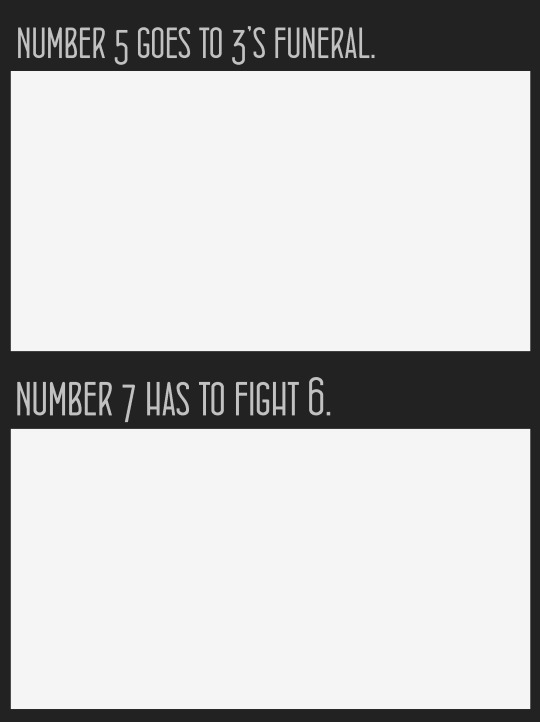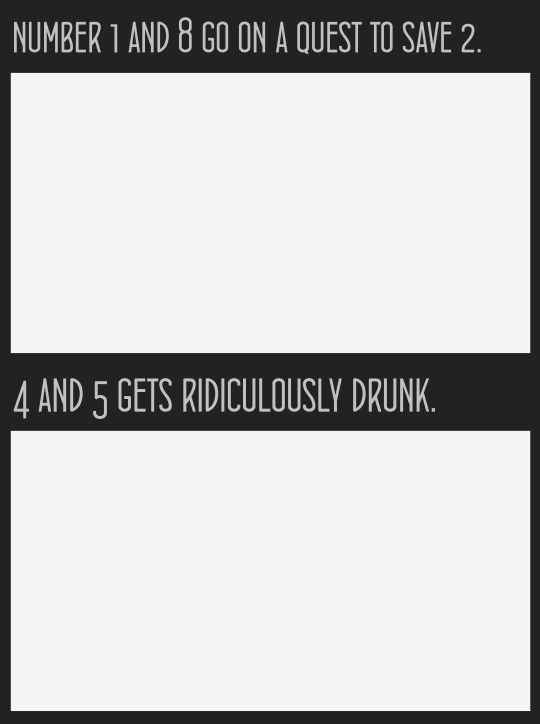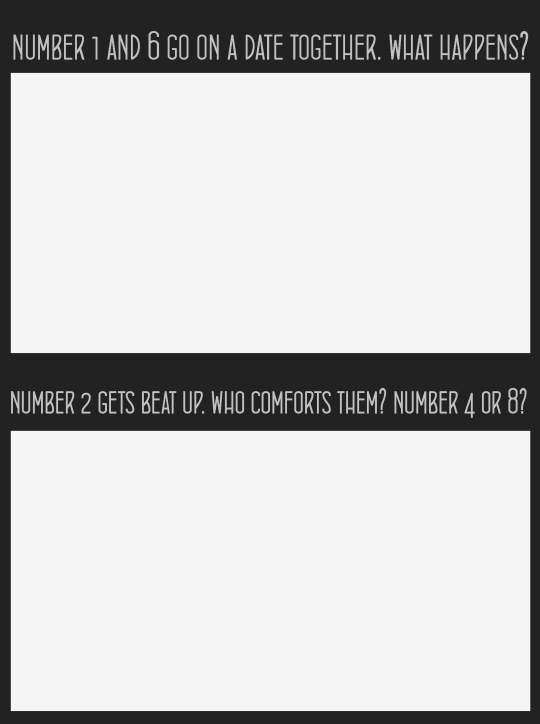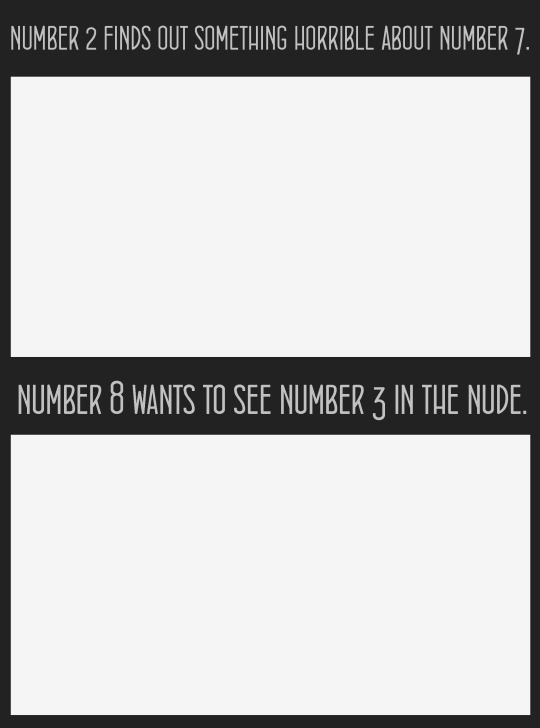I look for answers, but I only ever find more questions.
Don't wanna be here? Send us removal request.
Text
WBJ 4
History
2089
Amidst a global trade-off of leadership and an impending nomination of a world leader, it begins to rain.
It keeps raining.
And raining.
It doesn’t stop.
2090
Torrential downpours last for months, and panic begins to rise with the water levels - global media begins urging residents of earth to prepare for “Noah’s Flood 2.0.”
Qatari leader, world-leader candidate, and owner of Zaman Enterprises, Femi Zaman (also the wealthiest man in the world) starts buying out “safe zones” and investing in a variety of industries. Construction of an alleged “megaship” begins on the island of Pearl-Qatar.
Other stuff also happens, but I don’t yet know what is relevant to the story.
2091
Panic levels are at an all-time high - world leaders have issued a media blackout and governments have altogether dropped off the grid. Some try to maintain law enforcement as crowds fight to occupy safe zones but efforts are futile. Crime is rampant and the death rate rises; finding land becomes a priority in the fight for survival.
Those who can’t afford shelter in Zaman’s near-empty safe zones begin to organize an insurrection and join forces to muscle their way in. Some safe zones are breached but even the highest areas are rapidly going underwater and the insurrectionists resort to seek out Zaman’s megaship project.
Zaman’s project has been handed over to Emory Rainflayer, former U.S. Secretary of Defense. Security revolving the project is extremely heavy, making victory virtually impossible for the revolutionists. Many of Zaman’s other investments are now in Rainflayer’s name as well, and no one seems to know what happened to Zaman [omnipotent author sidebar: Zaman has devoted all his time and resources to some sort of space-colonization shindig. I think.].
2092
The rain slows ever so slightly, but doesn’t let up and the revolutionists don’t give up their fight to get aboard Rainflayer’s mega residential ship. Other people have given up fighting, gathered as many supplies as they could, slapped together makeshift floating shelters, and - praying for God’s mercy - set for sea.
2093:
The last of the land goes underwater and the terra revolution dies with the departure of the Destiny. The last of the revolutionists join a somber cast-off of boats and rafts from “Refuge Peak,” stepping off of land for good and setting off to discover what the new AquaPlanet Earth has in store for them.
STORY BEGINS.
Fin.

3 notes
·
View notes
Text
WBJ 3
People and Races
AquaPlanet Earth - countries are no longer in existence and cultures have transformed altogether.
I’m not entirely sure how to handle the spread of various races and ethnicities after a flood wipes out the Earth - it’s hard to predict what would happen, but I’m thinking people of the same race would tend to band together (mostly for ease of language) and kind of stay in the same area. I don’t know if that’s what I want to do, or if I want races to be more diverse around the drifts, making communication more difficult and hence making life generally more chaotic.

Regarding the various institutions on the water-
I was thinking Rainflayer to be of Korean establishment, yet Emory Rainflayer has always been African or African-American in my mind. I see him owning the industries but I see Korea having the resources for it. How might I explain this? EDIT: Rainflayer is, indirectly, of Qatari establishment. Femi Zaman, wealthiest man in the world, partners with Emory Rainflayer to establish the industries and then leaves it to Rainflayer to invest all of his time into a space program instead (hint hint at things to come).
The Circuit is definitely of Russian establishment, or maybe Italian. Language doesn’t matter in the Circuit so much because it revolves around fighting and killing, so participants find their way around language barriers by, you know, punching and shit.
Greybow is, unexpectedly, of Canadian/Alaskan establishment. I know the common stereotype of Canada is all nice and innocent so I wanted them running something rather unexpected. Maybe I’m wrong in doing this but I think it’s kinda funny, since Greybow is all bloodthirsty do-it-for-the-money. Later on I think the Greybow “hunters” will primarily be American and Spanish but it will almost certainly be established by Canada.

I was initially thinking racism kind of just evaporated in lieu of the religious beliefs that began to dictate things - the common belief is that the Flood was God’s doing and thus everyone left alive were His “holy ones.” Thus, everyone sort of believed all people they interacted with had as much right as they to be alive.
But then I consider the various institutions and the means people are going to have to take to survive, and of course race is going to be a factor in that. I’m kinda torn, but I guess it won’t be collective thought. Since Rainflayer is considered so powerful and icky, the most vehemence will probably be directed towards Koreans (even those not involved with Rainflayer). I don’t know, I’ll have to see how racial hatred transpires because I don’t think I’ll be working directly with too many Korean characters.

My MC is named Xanath Sola Rose - she goes by Sola for a good deal of the story, which I think is of Spanish/Catalan origin, and Xanath is also traced back to Mexican/Spanish origin. Her mother’s name is Bea and her father’s Remi - I envision Bea as this exotic Spanish-American woman, and Remi to be more European-American. Sola’s mother dies when she’s very young, though, so she would be raised more with her father’s culture and her childhood drift is primarily of American descent.
I didn’t really know how to tackle this prompt because there aren’t countries and places of origin aren’t really relevant. Need to develop some cultures, whether they’re founded by race or not. But that’s what I have right now.
Fin.

1 note
·
View note
Text
WBJ 2
Geography
The geography in Archipelago isn’t terribly complicated, since there’s no land. Which is good, since geography just isn’t my strong suit.

So the earth is covered in water. Hence, a lot of water.
The residential “towns” are called drifts - basically a conglomeration of boats, rafts, and the like where a group of people (a more average drift size is roughly 75 people) makes residence. Most of these drifts (though not all) are equipped with desalinization equipment and have also developed areas where plants can be grown and animals bred. Some drifts are poorer (think shanty towns) and don’t have such resources so their means of survival are more along the lines of thieving from other drifts.

Drifts are spread pretty far apart - some areas are more populated drift regions (think neighboring neighborhoods) for trading purposes, and some are more isolated - usually these are the Rainflayer-owned drifts, where aircraft delivery of supplies makes trading unnecessary.
Landmarks - I’m not sure I would consider them “landmarks,” exactly, but these are some widely-known institutions that are made sort of landmark-esque by popularity.
Greybow Base - a massive station made up of four oil tankers welded together that serves as the infamous bounty hunting guild’s base of operations. People come to this base to commission a variety of things, be it search requests, torture requests, assassination requests, etc. They’ll do virtually anything if you pay them enough.
The Destiny - Rainflayer’s mega residential ship; it tends to stay in one place with a wide berth of perimeter security, but does often relocate.
The Circuit - I haven’t yet decided what this is going to look like, but it’s a major fighting ring (both credit and to-the-death matches) that many people participate in to make a living. Very popular both for employment and entertainment.

That’s all I can really think of geography-wise. Again, it’s all set on water and everything is disarrayed. There’s no organization to where (or how) things are found.
Fin.

0 notes
Text
WBJ 1
Introduction
It’s late, unorganized, and possibly incoherent - but here it is. I rejoined Tumblr just for this, so slap me thrice and hand me to my momma if I don’t participate.

Why the PotC reference, you ask?
Well, for starters, because it’s an epic franchise. But also because my story is set on what I like to call AquaPlanet Earth. It doesn’t have pirates, necessarily, but there are lots of boats and there will be a fair deal of action and a character loosely based off of the one and only Jack Sparrow. Other than that, there’s really no other relation and I just like PotC.

Archipelago
Archipelago is a post-apocalyptic story, but not in the more common ruins-and-desolation fashion. The novel takes place after a massive deluge (tentatively called Lucifer’s Flood but oft referred to as Armageddon, Doomsday, the Great Flood, etc.) submerges all of earth’s continents/islands/lands.
Probable? Not likely. But hey, it’s fiction.

The prologue actually takes place as the last bit of land goes under. But wait, let me back up a little.
Rainflayer [Industries] - super rich, super wealthy, super powerful. Owned by Emory Rainflayer, a thus undeveloped faceless character. Pre-flood, R.I. specializes in oil and gas/petroleum with subsidiaries in commodities (trading), transport, pharmaceuticals, and construction. During the floods, R.I. is the first to start buying out and occupying “safe zones” (basically high areas). By the time 50% of land is underwater, R.I. owns 80% of the safe zones. They also took over some flailing grocery corporations and invested in space programs.
In the two-odd years it takes the flood to rise, R.I. built the mega-residential ship, the Destiny. The Destiny is built to accommodate 10,000+ passengers/residents but charges ludicrous rates for said accommodation, leaving residence available only for the few and elite.
Post-flood R.I. also owns many of the more profitable greenhouse/farm “drifts” (think water-bound towns). Basically, Rainflayer is the only one well-off enough to survive on this new AquaPlanet Earth.

Prologue - the background on Rainflayer was necessary because the prologue chronicles the end of the “Terra Revolution” against R.I., in which my MC’s parents take part. Long story short, poor people join together to oppose R.I.’s hogging of the safe zones and favoring of the wealthy. There’s a butt ton of space on the Destiny that could save a lot of people’s lives but R.I. refuses to lower the rates and leaves the people who can’t afford residence aboard it to their own means of surviving the flood. So the poor fight, but they’re unsuccessful, and the revolution dies as the last of the land goes underwater. About a decade later, a clandestine movement resurrects the pre-Flood revolution and rallies opposition against R.I. once again. But that’s not important right now.

Anyway, the concept is a world covered in water and the (rather brutal) institutions established as means of survival. Currency, education, religion, lore, and cultures altogether have transformed and everything is different. This month, I will figure out exactly how so.
Fin.

0 notes
Text
How to Create a Special Snowflake (No, Really! Creating Fiction Through the Snowflake Method)
Let’s talk about the Snowflake Method.
I’ve been dabbling with this writing method for the past few weeks, mostly because I feel as though when I go to write, if I don’t have some sort of backbone before going in, I end up staring at a blank document. With Camp NaNo right around the corner, I wanted to get this year off to a good start. In order to try to find a method that would help me stay on track, I stumbled across the Snowflake Method.
The essence of the snowflake method is that one expands a single sentence into the first draft of a novel. Now, this is a major oversimplification, as the official site provides a nine (with optional tenth) step design program that includes everything from character sheets to Excel. However, the concept of starting with a single sentence and expanding it geomtrically makes sense and could be helpful to those who have solid ideas but have difficulty expanding upon them. The official guide was written by Randy Ingermanson who worked as a software architect for many years, so if some of these steps seem a bit mechanical, that’s the reason. If one is technically-minded, a less organic method of novel planning is a sure-fire way to get a working first draft.
The first step of the snowflake method is simple: write a one-sentence summary of your novel. The shorter the better, no more than fifteen words. A one hour time limit is recommended by Randy, but I found that taking the full hour made me second guess my work and change what I had written numerous times. When writing the summary, refrain from using names and rely on descriptors, such as “insecure drama teacher,” “tall, stoic, mailman,” “disgruntled archaeologist,” et al. Randy also suggests reading the one-line blurbs on the New York Times best seller list if one needs inspiration.
The second step involves taking that one-sentence summary and expanding it into a full paragraph. The first time I sat down to write the paragraph I was not sure how to go about this step. I have written out a one sentence summary and the resulting paragraph for my favorite television show and included it at the bottom of this post. The recommended time limit for this step is an hour, and I can confidently say that I took every minute of that hour to write the paragraph. This step is important because it’s the basic outline of the novel. The paragraph should include and briefly describe each conflict and the ending. It doesn’t have to be pretty, it just needs to get the message across.
Give the characters some depth. The characters are the driving force of a novel, so it is important to give them dimension and make them believable. Write one sentence for each of the following: character’s storyline, motivation, goal, conflict, and epiphany. The final words on the page should be a paragraph expanding upon the one sentence character summary. There are plenty of character sheet examples on line if one needs inspiration.
This step is where the expansion begins to take place. Now that the short summaries have been created, it is time to expand each sentence of the summary into a full paragraph. This takes a lot of time; the recommended limit is a full day. This exercise is good for forming a clear idea of what one’s novel is supposed to be, and it’s fun to see the work materialize on the page. Very satisfying.
Now that the novel is beginning to take shape, it is time to write up one page character synopses for the major characters and half page synopses for the minor characters. This should take a day or two, more if the novel revolves around many major characters. At this point I took some time to go back and make changes to story where I felt there where inconsistencies or other issues. Going back and editing your work after completing a step will leave less work for you to do in the future.
Take one week and expand each paragraph from Step 4 to into an entire single-spaced page. This step allows the writer to dive deep into the wonders of world building and lore. Make sure to take some time and edit what was written before this step in order to avoid plot holes, or adding new ideas that were churned during this step.
It’s time to give the characters more depth. For those who love filling out character sheets (such as myself), this step should be very exciting. Now is the time to turn the short character descriptions into full sheets. These sheets should contain the basics like birthdate, motivation, physical description, and history, but the most important aspect of this exercise is writing out how the character changes throughout the course of the novel. There is no suggested time limit for this step.
As the end nears, it is time to step away from the word processor and become intimate with the spreadsheet. Make a list of all of the scenes needed to make the story into a novel. Using a spreadsheet for this step may seem gratuitous, but it helps when reorganization is needed. When writing out the scenes, give them just one line. In the first column, write the POV character. In the next column, give a description of what happens in the scene. This should be easy to do since the writer has spent at least five of these steps writing out the scenes of the story. For each iteration of the draft, create a new spreadsheet. When the final spreadsheet is finished, make a column assigning chapters to each scene.
Randy believes that this step is optional, but I chose to follow it. In this step, the writer writes a narrative description of the story. This is where the lines of the spreadsheet are expanded to be multiple paragraphs of the scene. Now is the time to sketch out the conflicts and make cuts if certain scenes don’t have purpose.
In the final step, once all of the work is cut out for the writer, it is time to sit down and type out the first draft of the novel. It may seem like this step is pointless, like novel is written already, and in many ways that is true. While this method instructed the writer to write down what seems to be endless amounts of the novel, it is not quite in a format that is publish-ready. If a writer struggles with completing a first draft, one should find that this step is a great relief because of how easily writing can be once all of the ideas have been solidified.
And that, writers, is my explanation of the snowflake method. I must admit, it’s not for everyone, and if you don’t have the time available I would advise against it. But, if one finds themself struggling with actually writing a first draft, this method may be useful.
I hope this post is helpful!
xx Sarah
Keep reading
604 notes
·
View notes
Text
DEAR RESEARCHERS OF TUMBLR
You know what’s awesome? Research. You know what’s not awesome? Not being able to get access to research because it’s stuck behind a paywall and you don’t belong to an institution/your institution doesn’t subscribe to that particular journal.
FEAR NOT.
Here is a list of free, open access materials on a variety of subjects. Feel free to add if you like!
GO FORTH AND LEARN SHIT, MY FRIENDS.
Directory of Open Access Journals- A compendium of over 9000 journals from 133 countries, multilingual and multidisciplinary.
Directory of Open Access Books- Like the above, but for ebooks. Also multidisciplinary.
Ubiquity Press- Journals covering archaeology, comics scholarship, museum studies, psychology, history, international development, and more. Also publishes open access ebooks on a wide variety of subjects.
Europeana- Digital library about the history and culture of Europe.
Digital Public Library of America- American history, culture, economics, SO MUCH AMERICA.
Internet Archive- In addition to books, they have music and videos, too. Free! And legal! They also have the Wayback Machine, which lets you see webpages as they looked at a particular time.
College and Research Libraries- Library science and information studies. Because that’s what I do.
Library of Congress Digital Collections- American history and culture, historic newspapers, sound recordings, photographs, and a ton of other neat stuff.
LSE Digital Library- London history, women’s history.
Wiley Open Access- Science things! Neurology, medicine, chemistry, ecology, engineering, food science, biology, psychology, veterinary medicine.
SpringerOpen- Mainly STEM journals, looooong list.
Elsevier Open Access- Elsevier’s kind of the devil but you might as well take advantage of this. Mainly STEM, also a linguistics journal and a medical journal in Spanish.
113K notes
·
View notes
Link
The imagining of possible worlds is the staple of science fiction. As expert Bruce Sterling puts it, science fiction (or SF or sci-fi for short) is ‘a form of fiction that deals principally with the impact of actual or imagined science upon society or individuals’. In speculative fiction this impact can be strictly technological (as in novels featuring robots or degrees of space exploration not yet possible) or it may be environmental (as in Margaret Atwood’s The Year of the Flood). Here are 43 must-visit sci-fi websites for writers…
Keep Reading
1K notes
·
View notes
Photo







remember these, kids? they used to be so popular on deviantART way back in like 2008 and i remember i used to be so pumped about doing one, though i never really did. so, last night i even had a dream about doing one of these, so i put together some scenarios and here we are, haha! feel free to reblog or save the template for yourself if it catches your fancy!
95K notes
·
View notes
Quote
Writing is about dealing with failure all the time. Writing is about very often not quite getting to what you’re hoping to get to. Then coming back the next day and getting closer or realizing, “Oh, that wasn’t as bad as I thought it was.”
Brian Koppelman on “Accidental Creative” (via graphei)
3K notes
·
View notes
Conversation
Age of Ultron summed up
Everyone: hoe don't do it
Tony: I'm gonna do it
Everyone: OH MY GOD
773 notes
·
View notes
Photo

10 writing tips and the psychology behind them
3K notes
·
View notes
Text
OPEN CALL FOR WRITERS: Unconventional Love

This is an open call for “Unconventional Love”; an anthology of short romantic fiction that revolves around attending a convention. The convention does not need to be limited to fan-based franchises, it can be anything from a work convention, to an alien abductee support convention.
Any story containing copyrighted characters and real life persons are not permitted. Blatant spoofs on preexisting franchises or real like people are permitted.
All gender pairings, sub-genre, and content rating are accepted for this book, but the main theme has to be romance and a convention setting. The word limit is a 15,000 word maximum with no minimum word count.
Authors will retain the copyright to their work, receive $30.00USD for accepted works, and receive a free paperback copy of the book upon publication. Authors from all over the world and from any age group (under the age of 18 is accepted) are invited to submit their stories. The submission deadline is August 31, 2015.
Please email all submissions in Word format to [email protected] . Feel free to email any questions to the same address.
2K notes
·
View notes
Quote
The bigger the issue, the smaller you write. Remember that. You don’t write about the horrors of war. No. You write about a kid’s burnt socks lying on the road. You pick the smallest manageable part of the big thing, and you work off the resonance.
Richard Price (via redqueenofbookland)
19K notes
·
View notes
Photo

A synopsis is a summary of your manuscript. That’s it. You get a chance to answer the question “what’s your novel about?” in one single-spaced page in an omniscient narrative voice. Usually it is required in the query process (along with a query letter and sample pages). One tip that took off a lot of pressure for me is that the function of a synopsis is primarily practical. The synopsis is not about voice and beautifully-crafted prose—its purpose is to let the agent know what happens.
3K notes
·
View notes
Photo

A superfantastic infographic on the rhythm of a dramatic scene, from http://www.betternovelproject.com/blog/scene-structure/ definitely visit Better Novel Project! and K.M. Weiland’s book Structuring Your Novel is very good. Visit her blog at http://www.helpingwritersbecomeauthors.com/
2K notes
·
View notes
Text
Useful Writing Links!
I’ve been collecting a lot of helpful writing tools and tutorials and ideas so I thought I’d put them into one big post! Hopefully others will find them helpful. I’ve separated them into sections.
Ideas
Seventh Sanctum Generators
Serendipity Generators; fantasy generators
Prompts
AUs to Consider
Plot
6 Stage Plot Structure
How to Plot a Novel in a Day (It WILL take all Day)
The Thirty-Six Dramatic Situations
This is a Plot
On Plot Details
Words
This Sentence has Five Words
Said is Dead; words other than ‘said’
Tip of My Tongue; finding the word you can’t remember
Pun Generator
Tools
Hemingway; a editing app I would die without
Pacemaker; a word count planing tool
FreeMind; a mind mapping tool
Writing Dirty (aka Sex)
Smut Guides of Tumblr
On Kissing
On Foreplay
The Sex Ed Guide your Parents Didn’t Give You
Writing Believable Sex Scenes
How to Write a Blowjob
Tips from Pregnancy Smut
The Dirty Dictionary; dictionary of fetishes, euphemisms, sex positions, ect.
List of All Sex Positions
Kink Wiki
Smut Playlists
Characters
The Mary Sue Test
Ways to Reveal a Character
On Writing a Vampire
Things that say a lot about people
Anti-Villain Motivations Besides “Tragic Past”
Villain Archetypes
How to Use Mental Illness in Your Writing
Surnames Masterpost
About Minor Character Development
World Building
Things that get Over Looked
Critique
Wattpad
FictionPress
Authonomy
Full Immersion Writing Programs
FocusWriter is free and open source
WriteMonkey for Windows is also free
Q10 (for windows) is also free
PyRoom; free and open source
TextRoom; free, open source, works on Windows and Mac and Linux
Write! (also free)
Writer’s Block
Surviving Writers’ Block
10 Types of Writer’s Block (And how to Over Come Them)
7K notes
·
View notes
Text
Top Ten Things That Are Not Impressive For Action Characters
Sticking the landing . All this does is jack up joints. Collapse and roll. Hit the ground with the largest surface area possible.
Headshots . You sound like bragging gamers.
“One shot, one kill.” Same as above. Aim for center mass and unload until they stop moving.
Disabling shots . Depending on the time period, you’re either consigning them to a lifetime of nerve damage and pain or a slow death from infection. Also, injured people can still fight back.
Anything with a flip . Telegraphing your moves and taking several extra seconds to get it done just allows the other fighter time to block.
Throwing people . Unless you’re literally trying to get some space for an escape or a ranged weapon, why did you throw them? It takes a ton of effort and now they’re all the way over there.
Prolonged fights . Most brawls are over in seconds. Seconds. Competition fights last longer because there are safety limits and controls in place.
Ignoring backup . Congratulations on your ‘does not play well with others’ sticker.
Overly complicated weapons . Different weapons were developed to take advantage of specific conditions, be they environmental, tactical, or weaknesses in your opponent’s situation. Picking the wrong one because it looks cooler just puts you at a steep disadvantage.
Basically anything overcomplicated . Climbing in top floor windows when you could walk in the service entrance. Fighting through twelve guards when you could poison someone’s dinner. Training in eight martial arts styles when a pillow over the face will get them just as dead. It’s not really that impressive to make more work for yourself.
15K notes
·
View notes